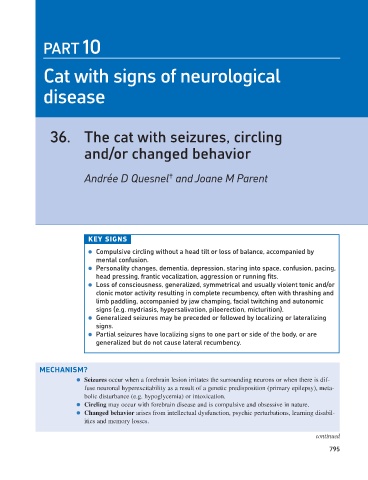Page 803 - Problem-Based Feline Medicine
P. 803
PART 10
Cat with signs of neurological
disease
36. The cat with seizures, circling
and/or changed behavior
†
Andrée D Quesnel and Joane M Parent
KEY SIGNS
● Compulsive circling without a head tilt or loss of balance, accompanied by
mental confusion.
● Personality changes, dementia, depression, staring into space, confusion, pacing,
head pressing, frantic vocalization, aggression or running fits.
● Loss of consciousness, generalized, symmetrical and usually violent tonic and/or
clonic motor activity resulting in complete recumbency, often with thrashing and
limb paddling, accompanied by jaw champing, facial twitching and autonomic
signs (e.g. mydriasis, hypersalivation, piloerection, micturition).
● Generalized seizures may be preceded or followed by localizing or lateralizing
signs.
● Partial seizures have localizing signs to one part or side of the body, or are
generalized but do not cause lateral recumbency.
MECHANISM?
● Seizures occur when a forebrain lesion irritates the surrounding neurons or when there is dif-
fuse neuronal hyperexcitability as a result of a genetic predisposition (primary epilepsy), meta-
bolic disturbance (e.g. hypoglycemia) or intoxication.
● Circling may occur with forebrain disease and is compulsive and obsessive in nature.
● Changed behavior arises from intellectual dysfunction, psychic perturbations, learning disabil-
ities and memory losses.
continued
795

